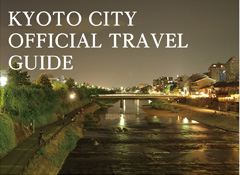【One Day Ticket】
North Kyoto Bus-and-Subway Day Ticket Course

Daitoku-ji Temple
Imamiya-jinja Shrine
Hirano-jinja Shrine
Kitano-tenmangu Temple
Start!
Subwai Karasuma Line Kitaoji Sta.
-

Toilet inside (beyond tkt barrier)
Subway Kitaoji Sta.
Daitoku-ji Temple
-
Imamiya-jinja Shrine
-
This shrine was established to assuage plagues that were prevalent back in the Heian period. Chinka-sai (Buddha's birthday f estival) to a ssuage p lagues a re h eld w ith a red-headed o gre and a b lack-headed one dancing to flute-and-drum music. And, if believers stand under large flower-decorated umbrellas called Furyugasa, they will be safe from the plague. This is noted as one of the three bizarre festivals of Kyoto. This shrine also is noted for helping women to marry into wealthy families, or tama-no-koshi, with the origin to this belief coming from the woman Otama who was a daughter of a greengrocer, but when seen by the third Tokugawa shogun Iemitsu, she soon became his concubine, and gave birth to the future fifth shogun Tsunayoshi and she herself became known as Keishoin. So, when people went to worship at local Shinto shrines, they purchased little amulets called "tama-no-koshi", with the "tama" part referring to Otama. In the grounds also there are stones. If one is tapped three times, and then lifted, and feels heavy, but is then rubbed three times, and then lifted, and feels lighter than when first lifted, the wish of the lifter will come true. There a re m any st eps a nd g ullies i n t he g rounds, s o wheelchair users will need assistance. 
Police box near Kinkaku-ji Temple
Kinkaku-ji Temple
-
This temple's formal name is Rokuon-ji, and it was built as a mountain retreat temple for Yoshimitsu Ashikaga, the third shogun to control the Muromachi Shogunate (1336-1573). The golden pavilion (Kinkaku) is a three-tiered structure representative of the Kitayama Culture that combined the cultures of samurais and nobles. The roof is topped with a Chinese firebird. The pavilion burned down in 1950 but was rebuilt in 1955. The garden also is famed as an excellent example of Muromachi design. The temple was registered as a World Heritage Site in 1994.

Public toilet in grounds of Kinkaku-ji Temple
Kamishichiken
-
Located close to the east gate of Kitano-Tenmangu Shrine, Kamishichiken is one of the five geisha quarters in Kyoto. Back in the Muromachi period, when Kitano-Tenmangu Shrine was being rebuilt, these seven teahouses ("shichiken", or seven houses) were built with the leftover materials from the shrine. Indeed, the whole area has the "feel" of Kyoto. And, after sunset, here and there, fleeting figures of geisha and maiko can be seen heading to the teahouses to entertain guests. The paper lanterns lighting the way outside this geisha quarter, and carry the local crest of skewered dango (sweet dumplings) that are associated with Kamishichiken. Taiko Hideyoshi Toyotomi enjoyed the dango here so much that he gave permission for them to be sold in Kyoto; thus, dango became the local crest.
Kitano-tenmangu Temple
-
This is the Grand Head shrine dedicated to Sugawara-no-Michizane, now referred to as "Tenjin-san", a Heian-period scholar and statesman who was treated badly by the Fujiwara clan, demoted and sent away from court to a minor posting at Daizaifu in Kyushu, where he died a disappointed m an. A fter t hat,the I mperial Court h ad Michizane's spirit enshrined in the Kitano area and that was the start of the Kitano-Tenmangu shrine, where, in line with Michizane's s cholarly e ndeavors, t he ka mi, o r g od (Tenjin-san), of knowledge, calligraphy and arts is deified. Thus many of the worshippers seek the blessing of the god at exam times or when wanting to improve at some art. As Michizane's birthday and death fell on the 25th, this day each month is celebrated as a festival day with an open-air market in the shrine grounds, to which many visitors flock each month. The s hrine h as w ide p aths a nd l evel g round ( no steps/ramped steps) to make visits easy for everyone. 
Toilet next to treasure hall in Kitano-tenmangu
Temple
Subway Karasuma Line Imadegawa Sta.
-

Toilet outside tkt barrier in Subway
Imadegawa Sta.















